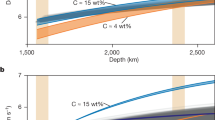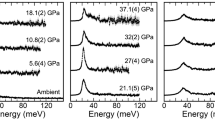Abstract
FROM studies of the density and elastic properties of the mantle, Birch1 showed that the upper mantle is characterized by a zero-pressure density of about 3.3 g cm−3 and (K/ρ)p = 0 about 35 km2 s−2, where K is the bulk modulus. The corresponding values for the lower mantle, however, are about 4 g cm−3 and 55 km2 s−2. Comparing these values with laboratory measurements for a number of materials showed that, while a number of common rock-forming minerals (olivine, pyroxene, garnet, jadeite) have the qualifications of the upper mantle material, none of the familiar silicates have similar properties to the lower mantle. The observation that a few oxides (periclase, corundum, rutile) have densities close to 4 g cm−3 and (K/ρ)p=0 close to 50 km2 s−2 inspired Birch1 to speculate that one of the possible phase changes in the transition zone is for silicates to break down into closely packed oxides. The popularity, and hence the importance, of this speculation is clearly indicated by the work of Al'tshuler et al.2, Ahrens and Syono3 and Anderson4. Al'tshuler et al. attempted to construct the equations of state of the high-pressure phases of forsterite and enstatite from the Hugoniot data for quartz and periclase; the constructed curves were compared with the P-ρ curve for the lower mantle. Anderson, on the other hand, calculated on thermodynamic grounds the temperature and pressure range for the breakdown of spinel polymorph of forsterite to form a mixture of closely packed oxides. The result was correlated with the density increase corresponding to one of the steep rises in the seismic velocity profile in layer c. In the light of shock-wave data, the nature of the phase change is examined here.
This is a preview of subscription content, access via your institution
Access options
Subscribe to this journal
Receive 51 print issues and online access
$199.00 per year
only $3.90 per issue
Buy this article
- Purchase on Springer Link
- Instant access to full article PDF
Prices may be subject to local taxes which are calculated during checkout
Similar content being viewed by others
References
Birch, F., J. Geophys. Res., 57, 227 (1952).
Al'tshuler, L. V., Trunin, R. F., and Simakov, G. V., Bull. Acad. Sci. USSR, Earth Phys. Ser., No. 9, 657.
Ahrens, T. J., and Syono, Y., J. Geophys. Res., 72, 4181 (1967).
Anderson, D., Science, 157, 1165 (1967).
Doran, D. G., Poulter Lab. Tech. Rep., 004–65 (Stanford Research Institute, 1965).
Chao, E. C. T., Science, 156, 192 (1967). Doran, D. G., and Linde, R. K., in Solid State Physics (edit. by Seitz, F., and Turnbull, D.), 19 (Academic Press, New York, 1966).
Dachille, F., Zeto, R. J., and Roy, R., Science, 140, 991 (1963).
Clark, jun., S. P., Geol. Soc. Amer. Memoir, 97, 97 (1966).
McQueen, R. G., Fritz, J. N., and Marsh, S. P., J. Geophys. Res., 68, 2319 (1963).
Wang, C. Y., Earth Planet. Sci. Lett., 2, 107 (1967).
Author information
Authors and Affiliations
Rights and permissions
About this article
Cite this article
WANG, CY. Shock-wave Data for Several Minerals and their Implication to Mineral Phases in the Lower Mantle. Nature 218, 560–561 (1968). https://doi.org/10.1038/218560a0
Received:
Published:
Issue Date:
DOI: https://doi.org/10.1038/218560a0
This article is cited by
-
A new high-pressure form of MgAl2O4
Nature (1991)
Comments
By submitting a comment you agree to abide by our Terms and Community Guidelines. If you find something abusive or that does not comply with our terms or guidelines please flag it as inappropriate.



